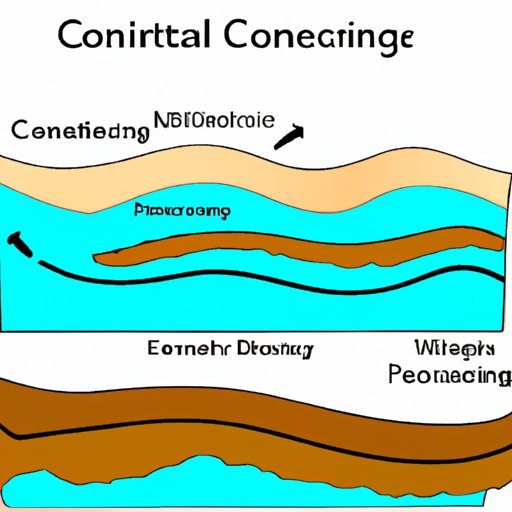Exploring Land Features That Support the Theory of Continental Drift
The theory of continental drift is the cornerstone of modern geology. Its discovery and subsequent development has revolutionized how geologists and other scientists study the Earth. Proposed in the early 20th century by Alfred Wegener, this theory posits that the continents were once joined together in a single supercontinent called Pangaea, which later broke apart and drifted to their current positions. A lot of evidence supports this theory, but this article will focus on the different land features that strongly support the theory of continental drift.
Mid-ocean ridges
Mid-ocean ridges are massive underwater mountain chains that run through the middle of the world’s oceans. They extend for over 40,000 miles and are caused by the separation of two oceanic plates. Here, molten magma rises from the mantle and forms new oceanic crust, which then pushes the old crust away from the ridge. Over millions of years, the pattern of seafloor spreading and the creation of new crust slowly cause the ocean basins to widen. This process is known as seafloor spreading and it helps support the theory of continental drift.
When the oceanic crust is created at the mid-ocean ridges, it is pushed away from the ridge in both directions. As it moves, it records the Earth’s magnetic field at the time of its formation. Because the Earth’s magnetic field changes over time, these rocks have different magnetic polarities. As a result, the rocks on the seafloor create distinct stripes of alternating magnetic polarity. These magnetic stripes provide conclusive evidence supporting the occurrence of seafloor spreading and the theory of continental drift as a whole.
Magnetic stripes on the seafloor
When geologists first discovered magnetic stripes on the seafloor, they were a puzzle. The stripes were symmetrical on both sides of the mid-ocean ridge, and the only explanation was that the oceanic crust was being formed at the ridge, spreading out on both sides, and pushing oceanic plates towards each other. When the oceanic plates meet and collide, the denser one descends under the other towards the mantle, forming a subduction zone.
Geologists discovered that, because of these collisions between oceanic plates and the creation of new seafloor at the mid-ocean ridges, new oceanic crust is always younger than the older crust. This highly unlikely positioning of rocks could only make sense if the ocean floor was being formed continuously at the mid-ocean ridges and spreading out in both directions. The discovery of magnetic stripes was one of the most significant pieces of evidence in support of the theory of plate tectonics and continental drift.
Earthquakes and volcanoes
Another land feature that supports the theory of continental drift is the distribution of earthquakes and volcanoes, which are related to plate tectonics. Earthquakes occur when two plates scrape past each other, producing a ground-shaking rupture. Meanwhile, volcanoes occur when an area of the Earth’s mantle, which is called the mantle plume, rises into the crust, causing magma to erupt upwards.
The majority of the world’s earthquakes and volcanoes occur along the boundaries of the plates. The tectonic activity is concentrated along the plate boundaries where the plates’ movement occurs and evidences the theory of continental drift. This natural observation supports the associated ideas of the Earth’s lithosphere broken into plates sliding past each other, leading to tectonic activity.
Repositioning of Continents
The movement and repositioning of continents over time demonstrates the theory of continental drift. A century ago, geologists thought that the world’s continents were stably arranged and had been in place forever. By studying different pieces of evidence, scientists have discovered that over time, the continents have gradually moved and repositioned themselves on the planet’s surface.
For instance, the East Coast of South America, which was once connected to the West Coast of Africa, has evidence from rocks and geological structures that these two continents were once together. Another example includes the India subcontinent, which was once off the African east coast before crashing into the Eurasian plate, causing the formation of the Himalayas.
Fossils and Plant/Animal Distribution
The distribution of fossils and plant and animal species is another land feature that supports the theory of continental drift. When Wegener first proposed the theory of continental drift, one piece of evidence that he cited was the fossil record. Fossils specimens of the same species were found on different continents separated by oceans.
For example, fossils of the Mesosaurus, a freshwater reptile found in Brazil and South Africa, show that these two areas must have been joined together at some point since the creature could not have swum across the ocean. Also, fossils of the plant Glossopteris have been found in Africa, South America, India, Australia, and Antarctica, suggesting that these continents must have been together in a single supercontinent, Pangaea, at some point.
Satellite Imagery
Over the years, technology has become more advanced, and satellite imagery has allowed scientists to track the movement of continents precisely. Satellites in space can see the edges of continents, allowing scientists to measure the rate of tectonic movement over time. For instance, technology has revealed that some regions of the San Andreas Fault in California move an inch or two every year. In many places, over time, this movement is responsible for the creation of new mountains or the widening of valleys.
Conclusion
In conclusion, the theory of continental drift is a significant piece of evidence in understanding our planet’s geological history. The various land features described above that support this theory, including mid-ocean ridges, the distribution of earthquakes and volcanoes, and the distribution of fossils and plant and animal species, have helped to demonstrate the concept’s validity. Advances in technology have only helped to confirm the theory of continental drift. Understanding this theory is essential because it provides a comprehensive view of the Earth’s history and can help us better predict how the planet will continue to change in the future.
